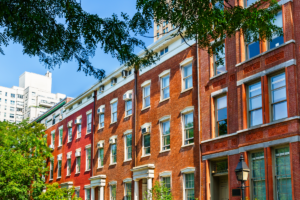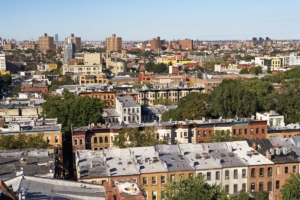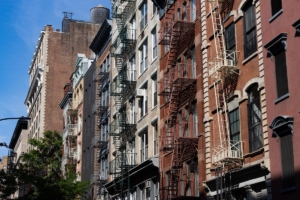Despite reaching all-time highs, New York City rents grew at the slowest annual pace on record in Brooklyn and Queens, and among the slowest rates ever seen by StreetEasy in Manhattan, according to the Q3 2017 StreetEasy® Market Reports[i].
Rents in all three boroughs grew less than half as quickly as in Q3 2016. Median rents in Brooklyn rose just 0.6 percent year-over-year to $2,460, and median rents in Queens rose 0.7 percent, to $1,991 — both the slowest growth rates ever observed by StreetEasy[ii]. Manhattan’s median rents rose 0.7 percent to $2,989, showing some of the slowest annual growth on record since the Great Recession— apart from the first two quarters of 2017, when rents were essentially stagnant.
Resale prices in Brooklyn and Manhattan grew modestly in the third quarter, rising 3.6 percent year-over-year to $754,094 in Brooklyn and 0.9 percent year-over-year to $1,168,557 in Manhattan. Resale prices in Queens grew the most of the three boroughs, up 9.3 percent year-over-year to $513,731. This marks the largest annual price growth on record, more than triple the growth rates of the same time last year, and the highest median resale price on record for the borough.
“While rents remain high, they’re growing at a snail’s pace. Part of this can be attributed to the onslaught of new construction driving up competition among landlords, but ultimately there is a limit to what renters are willing to pay,” said StreetEasy Senior Economist Grant Long. “After years of growth, rents in the city may have reached the peak of what New Yorkers can afford, and high-end rents in particular are stagnating or even beginning to drop in Brooklyn and Queens. If current patterns continue, rents across the board will likely fall as new units coming onto the market are forced to compete with leftover summer inventory during one of the slowest times of the year.”
See below for additional sales and rental market trends across Manhattan, Brooklyn and Queens.
Q3 2017 Key Findings – Manhattan
- Rents grew at one of the slowest paces on record. Median rents rose 0.7 percent from Q3 2016 to $2,989[iii], less than half the rate of growth seen in Q3 of last year (1.5 percent).
- Upper Manhattan rents grew the least. Median rents in the Upper Manhattan submarket failed to lead the borough for the first time in six years, growing just 0.6 percent to $2,202.
- Upper East Side rents increased the most. Aided by improved transportation options, the Upper East Side saw the largest rent increase of any Manhattan submarket, rising 1.6 percent since last year to $2,644.
- Manhattan price growth slowed; prices fell in Midtown. Manhattan’s median resale price rose slightly by 0.9 percent to $1,168,557[iv]. Midtown prices fell 1.5 percent from last year to $1,200,884, making it the only submarket where prices fell.
- Luxury home prices fell; sellers offered 2 percent more price cuts. Prices for the most expensive homes fell by 3.9 percent since last year, more than double the annual price decrease seen in Q3 2016 (-1.6 percent). Eighteen percent of luxury units received a price cut during the quarter, up from 16 percent during Q3 of last year.
Q3 2017 Key Findings – Brooklyn
- Brooklyn rents grew at their slowest pace on record. Median rents rose 0.6 percent to $2,460, marking the slowest growth rate since 2011. At this time last year, rents grew nearly three times faster (1.6 percent).
- North Brooklyn rents dropped, offered the most discounts. North Brooklyn was the only submarket to see rents decline, dropping 0.5 percent since last year to $3,067. It also offered the most listing discounts and was the only submarket where the share of discounts rose: 31 percent of rental listings saw a price cut during the quarter, up 2 percent since Q3 2016.
- Resale prices rose, particularly in South Brooklyn. The median resale price in Brooklyn rose 3.6 percent since last year to $754,094. South Brooklyn resale prices grew the most in the borough, up 7.4 percent year-over-year to $706,840.
- Prospect Park’s resale prices fell. Resale prices in the Prospect Park submarket fell 0.7 percent year-over-year to $957,960, the only Brooklyn submarket where prices declined.
Q3 2017 Key Findings – Queens
- Queens saw record-low rent growth. After outpacing the other boroughs since the beginning of 2016, annual rent growth in Queens slowed to 0.7 percent, falling in line with Brooklyn and Manhattan and reaching a median rent of $1,991.
- Northeast Queens rents rose the most. Median rent in the Northeast Queens submarket rose 3.0 percent since last year to $1,910.
- More than a quarter of all rentals in Clearview, Corona and Ridgewood offered discounts. Clearview rentals had the highest share of price cuts in Queens (30 percent), followed by Corona and Ridgewood (both 27 percent).
- Queens resale prices rose faster than Manhattan and Brooklyn. The median resale price in Queens rose 9.3 percent year-over-year to $513,731.
- Price cuts spiked. The share of for-sale homes with a price cut increased to 16 percent in the third quarter, up 5 percent year-over-year.
[tableau server=”public.tableau.com” workbook=”Q32017-ShareOfRentalsDiscounted” view=”Dashboard1″ tabs=”no” toolbar=”no” revert=”” refresh=”yes” linktarget=”” width=”800px” height=”850px”][/tableau] [tableau server=”public.tableau.com” workbook=”2017Q3MarketOverview” view=”NeighborhoodData” tabs=”no” toolbar=”no” revert=”” refresh=”yes” linktarget=”” width=”800px” height=”900px”][/tableau] [i] The StreetEasy Market Reports are a monthly overview of the Manhattan, Brooklyn and Queens sales and rental markets. Every three months, a quarterly analysis is published. The report data is aggregated from public recorded sales and listings data from real estate brokerages that provide comprehensive coverage of Manhattan, Brooklyn and Queens with more than a decade of history for most metrics. The reports are compiled by the StreetEasy Research team. For more information, visit http://streeteasy.com/blog/market-reports/. StreetEasy tracks data for all five boroughs within New York City, but currently only produces reports for Manhattan, Brooklyn and Queens. [ii] StreetEasy has tracked rent prices and annual growth rates since 2007 in Manhattan, 2010 in Brooklyn, and 2012 in Queens. [iii] Similar to the StreetEasy Price Indices, median rents are measured by the StreetEasy Rent Indices. By including only valid and verified listings from StreetEasy and employing a repeat rentals approach, the indices emphasize the changes in rent on individual properties and not between different sets of properties. Full methodology here: http://streeteasy.com/blog/methodology-price-and-rent-indices/ [iv] Median resale price is measured by the StreetEasy Price Indices, monthly indices that track changes in resale prices of condo, co-op, and townhouse units. Each index uses a repeat-sales method of comparing the sales prices of the same properties since January 1995 in Manhattan and January 2007 in Brooklyn and Queens. Given this methodology, each index accurately captures the change in home prices by controlling for the varying composition of homes sold in a given month. Data on sale of homes is sourced from the New York City Department of Finance. Full methodology here: http://streeteasy.com/blog/methodology-price-and-rent-indices/
—
Hey, why not like StreetEasy on Facebook and follow @streeteasy on Instagram?
Related:









